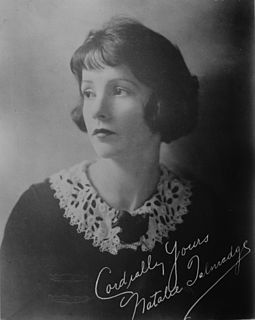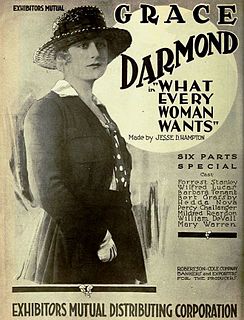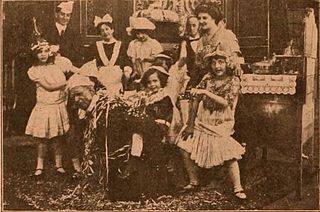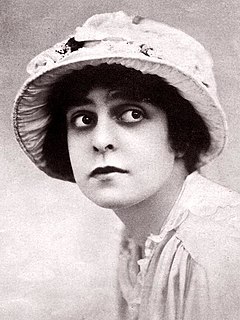Related Research Articles

Gladys Louise Smith, known professionally as Mary Pickford, was a Canadian-American film actress and producer with a career that spanned five decades. A pioneer in the American film industry, she co-founded Pickford–Fairbanks Studios and United Artists, and was one of the 36 founders of the Academy of Motion Picture Arts and Sciences.

Natalie Talmadge was an American silent film actress who was best known as the wife of Buster Keaton, and sister of the movie stars Norma and Constance Talmadge. She retired from acting in 1923.

Salomé is a 1918 American silent drama film produced by William Fox and starring actress Theda Bara.

Ethel Clayton was an American actress of the silent film era.

Ouida Bergère was an American screenwriter and actress.

Linda Arvidson was an American actress who became one of the early movie stars. Because actors usually were not credited on screen in the first years of cinema, she often was referred to as simply one of the Biograph Girls. Arvidson had been encouraged to work in the new medium by her future husband D.W. Griffith, who impressed her as an innovative film director. Their marriage was kept secret for reasons of professional discretion.

Irene Fenwick was an American stage and silent film actress. She was married to Lionel Barrymore from 1923 until her death in 1936. Fenwick has several surviving features, mainly because she worked for the Kleine-Edison Feature Film Service, which has numerous surviving shorts in the Library of Congress.

Don't Change Your Husband is a 1919 American silent comedy film directed by Cecil B. DeMille and starring Gloria Swanson. The film was the third of six "marriage films" directed by DeMille and the first DeMille film starring Gloria Swanson. A print of the film is stored at the George Eastman House. The film was released on DVD by Image Entertainment with The Golden Chance.

What Every Woman Wants is a 1919 American drama film directed by Jesse D. Hampton and starring Grace Darmond, Wilfred Lucas, Forrest Stanley, and Claire Du Brey. Based on a screenplay by William Parker, the film was released by the Robertson-Cole Pictures Corporation.
Across the Plains is a 1911 American western directed by Broncho Billy Anderson and Thomas H. Ince and starring Anderson. The film's plot has Jennie Lee and her father heading to California in a prairie schooner. Jennie Lee's father becomes intoxicated before Indians attack them for trespassing on the land. Unable to convince her father to get in the carriage, Jennie Lee flees and races the Indians and is led to a deserted shack by a cowboy as his partner heads off for aid. The two are saved as the ranchmen return and disperse the Indians. The film was not released with a cast of credits as typical of its production era. The production took place on the Miller Brothers 101 Ranch and was released under the Essany label. The completed film was approximately 990 feet in length and was met with mixed reviews. The film's status is unknown, but likely lost.

Who Cares? is a lost 1919 American silent film comedy starring Constance Talmadge and Harrison Ford. The director was Walter Edwards who usually worked with Marguerite Clark. Julia Crawford Ivers wrote the scenario based on a Cosmo Hamilton novel and her son James Van Trees was the film's cinematographer.
The Gnome Motion Picture Company was a film production company that is credited with three productions between 1910 and 1911. The purpose of the company to was to produce stories about gnomes. Alice in Funnyland, The Birth of the Gnomes and Alice's New Year's Party were all productions that were most likely never released. Announcements in trade publications ceased in January 1911 and the company treasurer, Frederick Kalmbach, was later sued by the City of New York for taxes. Of the three planned productions, two official synopses were released in The Nickelodeon. Despite no evidence of an actual release, the American Film Institute still recognizes all three films as being released in January 1911.

She's Done it Again is a 1910 American silent short comedy written by Lloyd Lonergan and produced by the Thanhouser Company in New Rochelle, New York. A thief named Sikes decides to rob a society woman who falsely claimed to have been robbed when she in fact pawned her jewelry. A gentleman thief strikes and robs her, but no one believes her. The thief is caught only by a clever detective. The film was the third release of the Thanhouser company and featured the leading players, Anna Rosemond and Frank H. Crane. The film was met with positive reviews, but is presumed to be lost.

The Mermaid is a 1910 American silent short comedy produced by the Thanhouser Company. The film focuses on John Gary, a hotel owner, who wants to revitalize his business. After reading about a reported mermaid sighting, he has his daughter Ethel pose as a mermaid and gets a newspaper reporter to witness and photograph the mermaid. The publicity results in the hotel becoming famous, but Ethel eventually discloses the joke to the guests of the hotel in her mermaid suit. The film was released on July 29, 1910 and was met with mostly positive reviews. The film is presumed lost.

Tangled Lives is a 1910 American silent short drama produced by the Thanhouser Company. The plot focuses on, John Hill, a bank cashier who decides to fakes his death after the manager finds his accounts are short. Before he can go through with the plan, a reporter interviews the wife, May, and decides to suppress the story because he has become infatuated with her. Five years pass, May and the reporter decide to marry, but John returns on the day of the wedding. Upon sneaking into the house, he sees their love and decides to disappear. As he attempts to leave he accidentally falls to his death and the reporter removes his body before he leads May to the altar. The film was described as a variant of Enoch Arden by one reviewer, but it differs in its execution. The cast and credits of the film are unknown, but a surviving film still shows the principal characters. The film was released on September 13, 1910, to positive reviews. The film is presumed lost.

Oh, What a Knight! is a 1910 American silent short drama produced by the Thanhouser Company. The film follows a young woman, named May Brandon, who dreams a medieval fantasy in which she is wooed, rescued and married by a loyal knight. When she awakes, she dismisses her fiancé and tells him of her dream. He decides to become the knight of her dreams and dresses as one, but the experience is unpleasant and ruins her fantasy. There are no known staff or cast credits for the film, but a surviving film still shows three actors. The film was released on October 18, 1910 and was met with praise by The New York Dramatic Mirror. The film had a wide national release and was also shown in Canada, but is now presumed lost.

Their Child is a 1910 American silent short drama produced by the Thanhouser Company. The film begins with Ellen Stokes whose extravagant lifestyle is outside the means of the family. While their only son is hosting a birthday party, the husband informs Ellen that they are financially ruined because of her. Ellen attempts to get money from her uncle, who refuses, and a friend of the family soon comes to her aid with a loan. Ellen is deceptive in telling who provided the money and her jealous husband soon learns the truth. In anger, he takes the child and leaves. The child soon returns to Ellen and she whisks him away to a new home where she fails to obtain gainful employment. The son decides to sell newspapers for some money and in this job is recognized by his father, soon the family is reunited. Marie Eline played the role of "their child" and was likely so well disguised that the reviewer for The Nickelodeon believed her to be a boy. The film was released on October 21, 1910, and was met with positive reviews. The film is presumed lost.

Gerda Holmes, née Gerda Helen Elfrida Henius, was an actress during the silent film era and in theater. She had major roles in numerous films including The Fable of Elvira and Farina and the Meal Ticket (1915) and The Iron Ring (1917) with Arthur Ashley.

Two Men of Sandy Bar is a 1916 American silent Western Melodrama directed by Lloyd B. Carleton and starring Hobart Bosworth, Gretchen Lederer along with Emory Johnson. The film relies on a Bret Harte play penned in 1876. The film's main character is John Oakhurst, a character well known to the readers of Bret Harte's books. Oakhurst is an honest gambler whose compassion for others both wins him friends and causes hardships. A recurring theme in this film is using the bond of friendship to overcome life's obstacles. The film was released on April 3, 1916 by Universal.

Birdie Sherman Crooks, known professionally as Cathrine Countiss — often misspelled in media as Catherine Countiss — was an American actress at the beginning of the 20th century. She appeared in multiple Broadway productions, traveling stock companies, vaudeville tours, and silent films, traveling across the United States and portions of Canada during her career that spanned the years 1901 through 1915. She was married three times including to Edward D. Price, who was also her theatrical agent during their time of marriage.
References
- ↑ McMahan, Alison (2014-08-22). Alice Guy Blaché: Lost Visionary of the Cinema. Bloomsbury Publishing USA. p. 224. ISBN 9781501302695.
- ↑ Chalmers Publishing Company (1910). Moving Picture World (July-Dec 1910). New York The Museum of Modern Art Library. New York, Chalmers Publishing Company. p. 144.